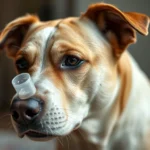
Dogs are known for their curious nature, and sometimes that curiosity can lead them to chew on things they shouldn’t, such as insulation. If you’re here because you’re worried about your furry friend after hearing the words, “my dog ate insulation vet answer,” you’re not alone. Many dog owners face this dilemma, and understanding the risks and required actions is crucial for their pet’s health.
Understanding Insulation and Its Types
What is Insulation?
Insulation is a material used in homes to reduce heat transfer, enhancing energy efficiency and comfort. Its purpose is to keep homes warm in winter and cool in summer, but it can pose serious risks if ingested by pets.
Types of Insulation Dogs May Encounter
Dogs may encounter several types of insulation, each with its own potential risks:
- Fiberglass Insulation: Made from fine glass fibers, this type can cause irritation to the mouth and digestive tract if ingested.
- Foam Board Insulation: Often made from polystyrene, this insulation can cause choking and digestive blockages.
- Cellulose Insulation: Typically made from recycled paper products, cellulose can lead to gastrointestinal issues if consumed.
- Spray Foam Insulation: Composed of chemicals that can be toxic, ingestion can lead to severe health complications.
Why Dogs Eat Insulation
Natural Instincts
Dogs are naturally inclined to chew. This behavior is rooted in their instincts, as chewing helps to keep their teeth clean and jaws strong. However, this instinct can lead them to explore inappropriate items, including insulation.
Boredom and Anxiety
A lack of stimulation can lead to destructive behaviors in dogs. If a dog feels bored or anxious, it might chew on insulation as a way to relieve stress or occupy itself. Common signs of anxiety include excessive barking, pacing, or destructive chewing.
Attraction to Texture or Smell
Insulation materials may carry scents or textures that attract dogs. They might find the feel of insulation appealing or be drawn to any odors that linger on the material, prompting them to chew.
Risks Associated with Dogs Eating Insulation
Physical Risks
The physical dangers of a dog eating insulation are significant and can include:
- Obstruction of the Digestive Tract: Large pieces of insulation can cause blockages that require surgical intervention.
- Potential for Choking: Smaller parts can pose a choking hazard, leading to respiratory distress.
- Toxicity of Certain Insulation Materials: Some insulation types contain chemicals that can be toxic, leading to severe health issues.
Behavioral Risks
Allowing your dog to engage in destructive chewing can reinforce bad habits. If they learn that chewing on insulation is acceptable, they may continue to seek out inappropriate items, leading to ongoing problems.
Long-term Health Risks
Ingesting insulation can lead to chronic digestive issues, including inflammation and upset stomach. Additionally, some dogs may develop allergic reactions to the materials used in insulation, leading to more severe health consequences.
Symptoms to Watch For After Ingestion
Immediate Symptoms
If your dog has eaten insulation, keep an eye out for immediate symptoms, which can include:
- Vomiting: This may occur if the dog’s body is trying to expel the foreign material.
- Diarrhea: Ingesting insulation can upset the digestive system, leading to diarrhea.
- Lethargy: A sudden drop in energy may indicate that something is wrong.
Severe Symptoms
More severe symptoms that require immediate veterinary attention include:
- Abdominal Pain: Dogs may show signs of discomfort, such as whining or restlessness.
- Difficulty Breathing: If your dog seems to be struggling to breathe, this is a critical emergency.
- Signs of Distress: Look for unusual behaviors, such as excessive drooling or pacing.
When to Seek Veterinary Help
Monitoring your dog is essential. If any of the above symptoms occur, or if you are unsure about the amount of insulation ingested, it’s crucial to consult your veterinarian immediately. Early intervention can prevent serious complications.
What to Do if Your Dog Eats Insulation
Assess the Situation
First, assess how much insulation your dog consumed and whether they are showing any immediate symptoms. This information will guide your next steps.
Home Remedies vs. Veterinary Care
While some dog owners may consider home remedies, it’s important to note that many can be ineffective or even harmful. If you suspect your dog has ingested insulation, it’s best to contact your veterinarian rather than trying to treat the issue at home.
Preparing for the Vet Visit
When preparing for a vet visit, gather as much information as possible. Be ready to share:
- The type and amount of insulation consumed.
- Any symptoms your dog is exhibiting.
- Your dog’s medical history and any medications they are currently taking.
Having this information will help your veterinarian make an informed diagnosis and treatment plan.
Veterinary Treatments for Ingestion of Insulation
Diagnosis and Examination
During your visit, the veterinarian will conduct a thorough examination. This may involve:
- Physical Examination: Checking for signs of distress and pain.
- Diagnostic Tests: X-rays or ultrasounds may be necessary to determine if there are any blockages.
Treatment Options
Depending on the severity of the situation, treatment options may include:
- Inducing Vomiting: If the ingestion was recent and the vet deems it safe, they may induce vomiting to expel the insulation.
- Surgical Intervention: In cases of severe obstruction, surgery may be necessary to remove the material.
- Medications: Pain management or anti-inflammatory medications may be prescribed to help your dog recover.
Follow-Up Care
After treatment, your vet may provide specific instructions for follow-up care. This could include dietary changes or restrictions to ensure your dog’s recovery and prevent future incidents.
Preventative Measures
Dog-Proofing Your Home
To prevent incidents of insulation ingestion, consider taking steps to dog-proof your home:
- Store Insulation Properly: Ensure insulation is stored safely and out of reach.
- Seal Off Areas: Use barriers to keep dogs away from areas where insulation is present.
Addressing Boredom and Anxiety
Engaging your dog with interactive toys, regular exercise, and training can help alleviate boredom and anxiety. Activities like agility training or puzzle toys can provide mental stimulation and reduce the risk of destructive behavior.
Regular Vet Check-Ups
Routine veterinary visits are crucial for maintaining your dog’s health. Regular check-ups can help identify potential health issues early, and forming a strong relationship with your vet ensures you have a reliable resource for advice and assistance.
Conclusion
If you find yourself concerned with the thought, “my dog ate insulation vet answer,” it’s essential to act quickly. Understanding the risks associated with insulation ingestion and recognizing the symptoms can make all the difference in your dog’s health. Always consult with a veterinarian for personalized advice and guidance tailored to your pet’s specific needs. Remember, immediate action can help prevent serious health complications, ensuring your furry companion stays healthy and happy.









